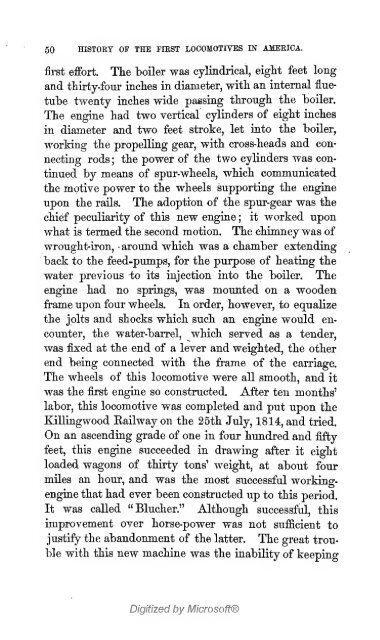The history of the first locomotives in America. From original ...
The history of the first locomotives in America. From original ...
The history of the first locomotives in America. From original ...
You also want an ePaper? Increase the reach of your titles
YUMPU automatically turns print PDFs into web optimized ePapers that Google loves.
50 HISTORY OF THE FIRST LOCOMOTIVES IN AMERICA.<br />
<strong>first</strong> effort. <strong>The</strong> boiler was cyl<strong>in</strong>drical, eight feet long<br />
and thirty-four <strong>in</strong>ches <strong>in</strong> diameter, with an <strong>in</strong>ternal flue-<br />
tube twenty <strong>in</strong>ches wide pass<strong>in</strong>g through <strong>the</strong> boiler.<br />
<strong>The</strong> eng<strong>in</strong>e had two vertical cyl<strong>in</strong>ders <strong>of</strong> eight <strong>in</strong>ches<br />
<strong>in</strong> diameter and two feet stroke, let <strong>in</strong>to <strong>the</strong> boiler,<br />
work<strong>in</strong>g <strong>the</strong> propell<strong>in</strong>g gear, with cross-heads and con-<br />
nect<strong>in</strong>g rods; <strong>the</strong> power <strong>of</strong> <strong>the</strong> two cyl<strong>in</strong>ders was cont<strong>in</strong>ued<br />
by means <strong>of</strong> spur-wheels, which communicated<br />
<strong>the</strong> motive power to <strong>the</strong> wheels support<strong>in</strong>g <strong>the</strong> eng<strong>in</strong>e<br />
upon <strong>the</strong> rails. <strong>The</strong> adoption <strong>of</strong> <strong>the</strong> spur-gear was <strong>the</strong><br />
chief peculiarity <strong>of</strong> this new eng<strong>in</strong>e ; it worked upon<br />
what is termed <strong>the</strong> second motion. <strong>The</strong> chimney was <strong>of</strong><br />
wrought-iron, around which was a chamber extend<strong>in</strong>g<br />
back to <strong>the</strong> feed-pumps, for <strong>the</strong> purpose <strong>of</strong> heat<strong>in</strong>g <strong>the</strong><br />
water previous io its <strong>in</strong>jection <strong>in</strong>to <strong>the</strong> boiler. <strong>The</strong><br />
eng<strong>in</strong>e had no spr<strong>in</strong>gs, was mounted on a wooden<br />
frame upon four wheels. In order, however, to equalize<br />
<strong>the</strong> jolts and shocks which such an eng<strong>in</strong>e would en-<br />
counter, <strong>the</strong> water-barrel, which served as a tender,<br />
was fixed at <strong>the</strong> end <strong>of</strong> a lever and weighted, <strong>the</strong> o<strong>the</strong>r<br />
end be<strong>in</strong>g connected with <strong>the</strong> frame <strong>of</strong> <strong>the</strong> carnage.<br />
<strong>The</strong> wheels <strong>of</strong> this locomotive were all smooth, and it<br />
was <strong>the</strong> <strong>first</strong> eng<strong>in</strong>e so constructed. After ten months'<br />
labor, this locomotive was completed and put upon <strong>the</strong><br />
Kill<strong>in</strong>gwood Railway on <strong>the</strong> 25th July, 1814, and tried.<br />
On an ascend<strong>in</strong>g grade <strong>of</strong> one <strong>in</strong> four hundred and fifty<br />
feet, this eng<strong>in</strong>e succeeded <strong>in</strong> draw<strong>in</strong>g after it eight<br />
loaded wagons <strong>of</strong> thirty tons' weight, at about four<br />
miles an hour, and was <strong>the</strong> most successful work<strong>in</strong>g-<br />
eng<strong>in</strong>e that had ever been constructed up to this period.<br />
It was called "Blucher." Although successful, this<br />
improvement over horse-power was not sufficient to<br />
justify <strong>the</strong> abandonment <strong>of</strong> <strong>the</strong> latter. <strong>The</strong> great trou-<br />
ble with this new mach<strong>in</strong>e was <strong>the</strong> <strong>in</strong>ability <strong>of</strong> keep<strong>in</strong>g<br />
Digitized by Micros<strong>of</strong>t®
















